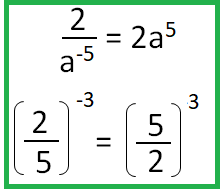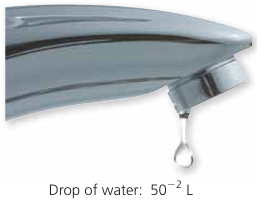SIMPLIFYING MONOMIALS WITH NEGATIVE EXPONENTS
Negative Exponent Rule :
To change the negative exponent as positive, we have two ways.
(i) Change the place
(ii) Take the reciprocal.

Base with negative sign :
If base is having negative sign, we have to consider the power.
- If the power is odd, the result will also have negative sign.
- If power is even, the result will have positive sign.
Write the expression with only positive exponents. Assume all variables represent non zero numbers. Simplify if necessary.
Problem 1 :
4r3(r4)3 / 15(r3)-2
(a) 4/15r21 (b) 4r21/15 (c) 4r9/15 (d) 4/15r9
Solution :
Problem 2 :
(-4x4y-5)3 (2x-1y)
(a) -8x5/y6 (b) -2x3/y4 (c) -8x-3/y4 (d) -8x3y6
Solution :
Problem 3 :
[(12x-5y-3 z4) / (3xy-3z-4)]-1
(a) x4/4z8 (b) x6/4z8 (c) 4x6/z8 (d) x6y6/4z8
Solution :
Problem 4 :
[(xy5) / (x3y)]-2
(a) 1/x8 y12 (b) x4/y8 (c) 1/x5y11 (d) y8/x4
Solution :
= [(xy5) / (x3y)]-2
= [(x3y) / (xy5)]2
By distributing the power, we get
= [ (x3x) / (y5 y) ]2
= (x4/y6)2
= (x8/y12)
Problem 5 :
Which is the simplified form of (3a2b3c-2)/(a-1b2c)3 ?
(a) 3a5/b3c5 (b) 3ab/c5 (c) 3/b2c5 (d) 3/ab3c5
Solution :
Problem 5 :
A jelly fish emits about 1.25 × 108 particles of light, or photons, in 6.25 × 10−4 second. How many photons does the jelly fish emit each second? Write your answer in scientific notation and in standard form.
Solution :
Number of particles it emits = 1.25 × 108
Time taken = 6.25 × 10−4
Number of photons that jelly fish emit = 6.25 × 10−4 seconds
unit rate = (1.25 × 108) / (6.25 × 10−4)
= (1.25/6.25) x 108 x 104
= 0.2 x 108+4
= 0.2 x 1012
Converting into scientific notation, we get
= 2 x 1012 - 1
= 2 x 1011
Jelly fish emits 2 x 1011 photons per second
Problem 6 :
A microscope magnifies an object 105 times. The length of an object is 10−7 meter. What is its magnified length?
Solution :
Length of the object = 10−7 meter
The size magnifies = 105 times
Length of object after it magnifies = 105 (10−7)
= 105-7
= 10-2
= 1/102
= 1/100
Problem 7 :
Simplify the expression. Write your answer using only positive exponents.
a) x-7
b) y0
c) 9x0 y-3
d) 15c-8 d0
e) (2-2 m-3)/n0
f) (100 r-11s)/32
g) (4-3 a0)/b-7
h) p-8 / 7-2 q-9
i) (22 y-6)/8-1 z0 x-7
Solution :
a) x-7
= 1/x7
b) y0
= 1
c) 9x0 y-3
= 9(1)/y3
= 9/y3
d) 15c-8 d0
= 15c-8 (1)
To convert the negative exponent to positive,
= 15/c8
e) (2-2 m-3)/n0
= (2-2 m-3)/(1)
= (1/22) (1/m3)
= (1/4/m3)
f) (100 r-11s)/32
= [(1) r-11s]/9
= ([1/r11]s) / 9
= s/9r11
g) (4-3 a0)/b-7
= (4-3 (1))/b-7
= b7/43
= b7/64
h) p-8 / 7-2 q-9
= 72 q9 / p8
= 49 q9 / p8
i) (22 y-6)/8-1 z0 x-7
= (4 y-6)/8-1 (1) x-7
= (4)(8) /y6 x-7
= 32x7/y6
Problem 8 :
The mass of a grain of sand is about 10-3 gram. About how many grains of sand are in the bag of sand?

Solution :
= 10 kg x (1000 g/1 kg) x (1 grain of sand/ 10-3)
= 104 x 103
= 104+3
= 107 grains of sand.
Problem 9 :
Evaluate and order 50, 54, and 5-5 from least to greatest
Solution :
50 = 1
54 = 625
5-5 = 1/55
= 1/3125
Ordering from least to greatest
5-5, 54, 50
Problem 10 :
A drop of water leaks from a faucet every second. How many liters of water leak from the faucet in 1 hour?

Solution :
1 hour = 3600 seconds
Water leaks from the faucet at a rate of 50-2 liter per second. Multiply the time by the rate.
3600 ⋅ 50−2 = 3600 ⋅ 1/502
= 3600 ⋅ 1/2500
= 3600/2500
= 1.44
So, 1.44 liters of water leak from the faucet in 1 hour.
Recent Articles
-
Finding Range of Values Inequality Problems
May 21, 24 08:51 PM
Finding Range of Values Inequality Problems -
Solving Two Step Inequality Word Problems
May 21, 24 08:51 AM
Solving Two Step Inequality Word Problems -
Exponential Function Context and Data Modeling
May 20, 24 10:45 PM
Exponential Function Context and Data Modeling